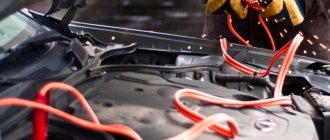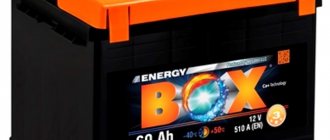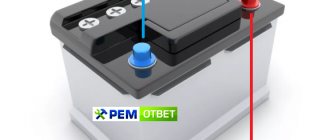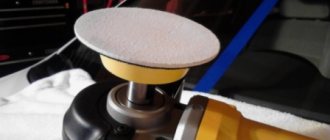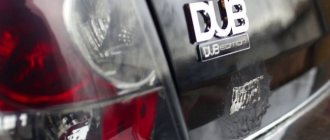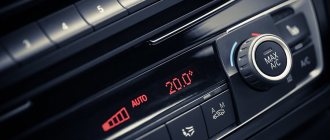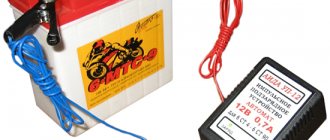Car batteries are designed for voltage - 12 V and direct current. They are connected using terminals, one of which has a positive charge, and the other has a negative charge. The plus is connected to the car's electrical system, and the minus is connected to the body (ground). Polarity is the relative placement of the terminals. Incorrect connection of the battery can result in damage to electrical equipment. But the problem is that the terminals on different batteries may be located differently.
Difference between forward and reverse polarity
There are the following types of battery polarity:
- straight – used in the Russian Federation;
- reverse - reverse polarity of the battery is typical for European-assembled cars, and cars assembled in the CIS countries are often equipped with straight-polar batteries.
Based on the arrangement of the elements, four types of polarity are distinguished: 2 types each for trucks and cars, although there are also several more, less common ones.
A battery with direct polarity differs from a battery with reverse polarity in the placement of current leads. But there are no differences in the principle of operation. Technical characteristics may be completely identical.
There are also Asian and American models. Some sources list them as additional species. However, this is not true because the differences relate to the size. Asian-made batteries are taller but smaller in width. In addition, the terminals of such devices are thinner. American-made batteries often have terminals on the side, which are made for bolt fastening. Moreover, Asian models are classified as reverse polar, and American models are classified as direct polar.
An analysis of different battery options will help you understand in more detail what reverse and direct polarity of a car battery are.
How to determine battery polarity
The determination method will be partially different for cars and trucks.
Cars
To determine which battery polarity is direct or reverse, you need to turn the device with the output elements facing you, the label will be located in front of your eyes. A battery is considered to be straight polar if first “+” is placed from left to right, then “–”. Such batteries are marked with the number “1” and are installed mainly on domestic cars and on individual foreign-made cars.
With reverse polarity batteries, the opposite is true: first there is a “minus”, then a “plus”. Such a battery is marked with the number “0”. But, despite the difference, it is possible to fail to understand what polarity a battery has only out of ignorance or in a hurry.
What is polarity
This term refers to the direction of movement of charged particles. It is important to remember: current always flows from the positively charged pole to the negative one. Determining where the plus and minus of a battery is is not difficult - there is usually a special designation:
- visual o, “-”;
- color designation:
- red terminal – positive charge;
- blue terminal – negative charge.
The driver only needs to connect the terminals correctly. The battery does not require special care. You just need to monitor the electrolyte level through a special window and observe the condition of the terminals. It is only important to position the connection correctly - plus to plus, minus to minus. Moreover, on different cars the location of the poles on the battery itself may differ.
Polarity can be of the following types:
Determining its type will not be difficult. The location of the terminals directly on the surface of the housing differs. It is important not to confuse the type of battery. This is the only way to avoid various problems and difficulties.
Trucks
To find out the polarity of a truck battery, you need to look at the terminals, turning the device with this side towards you. The terminals are often located on the short side. If the positive terminal is on the left and the negative terminal is on the right, then this is a reverse polarity battery, and it is designated by the number “3”.
The minus, located on the right, and the plus on the left define a straight-polar battery for a truck, which is designated by the number “4”.
In rare cases, there are also other battery layout options:
- “2” – the terminals are located diagonally.
- “6” - the sides of the battery are the same width, and the terminals are located on one side, from left to right “-”, then “+”.
- “9” – current carrying elements are located in the center of the short sides.
Additional ways to determine polarity
Determining the polarity of a battery is also possible by the appearance of individual elements. For a straight-polar battery:
- the positive terminal is larger than the negative terminal;
- The terminal pins are generally thicker.
Terminal thickness (mm)
| Orthopolar | Reverse polar | |
| Plus | 19,5 | 12,7 |
| Minus | 17,9 | 11,1 |
Difficulties with identification should not arise also for the reason that the manufacturer stamps “+” and “–” on the case next to the terminals or directly on the terminals.
In addition, they are marked with colors, respectively, “+” – red, “–” – blue or black:
- protective caps on terminal wires;
- terminal caps.
The battery itself may be marked with the letters “L” or “R”. The first indicates reverse polarity, the second - direct.
Note! In case of difficulties, manufacturers offer to use the online catalog to select the optimal battery model.
If there are no markings on the battery, then the polarity is determined using:
- multimeter - in the mode of measuring constant current voltage (U), the black probe is connected to the expected minus, and the red probe to the plus. If the inspector guesses the location of the poles, the device will display a voltage of “12 V”. If the polarity does not match, then the voltage will be “-12 V”;
- a weak solution of acid, such as citric acid. You need to connect copper wires to the battery terminals, screw one wire to the terminals at one end, and lower them into the solution with the other. It is important that the wires do not touch. Air bubbles will form where the negative wire is;
- raw potatoes. Copper wires are also used, but they need to be inserted into a potato cut in half at a distance of 5-10 mm from each other. Where there is a “+”, the potatoes will turn green;
- inspection of the terminals. In addition to the fact that the positive terminal is thicker than the negative terminal, a used battery has one more difference - the positive terminal has a white or green coating - oxide contamination.
Location of current carrying elements
Most often you can find two combinations of terminal locations. This is the polarity, which can be:
- Direct, when the positive terminal is on the left and the negative terminal on the right. Sometimes this distribution of current outputs is indicated by one, which can often be seen on batteries from domestic manufacturers. Finding the markings is quite simple; just turn the battery face down so that the current carrying elements are located at the bottom. If the plus is on the left, then it is straight polarity. Such batteries are installed on Russian cars. A striking example is Priora.
- Reverse, when the positive terminal is located on the right and the negative terminal on the left. Often this type of polarity is designated zero, which is considered a purely European development. The process of finding information about the location of the poles is the same. If the minus is on the left side of the label, this indicates reverse polarity of the battery. Most often, such batteries are found in foreign cars.
That's the whole classification of battery polarity for passenger cars. Even a schoolchild can figure this out, but there are times when there are no markings on the battery, and then you have to resort to improvised methods for determining direct and reverse polarity.
How to distinguish batteries
Often in the conversations of car enthusiasts the phrase about the mythical Asian and American polarity pops up. In fact, these are rumors: such things do not exist in nature. Most likely, the concept of location of current leads is confused with battery sizes. Asian-type batteries are distinguished by more compact sizes, the absence of a protrusion on the top cover of the device, and thin terminals. American batteries also have characteristic features - the location of current-carrying parts on the top panel.
As for the polarity of the battery, Russian and European can be easily distinguished by the location of the terminals or markings (0 and 1). Otherwise, the layout, box dimensions, number of cans and other external features are identical, so even an experienced motorist can get into trouble without looking at the label. In order not to guess, it’s easier to contact the seller, who will select a battery that matches a particular car brand.
Batteries for trucks
The terminal arrangement system on batteries for trucks is not much different from cars. Both terminals are on one of the short sides of the box. Determining the polarity of the battery is simple; you need to look at the location of the terminals:
- If the current terminal marked “+” is on the left side, then this is reverse (European) polarity, which can also be marked with a three.
- If the positive current-carrying element is placed on the right, then this is direct (Russian) polarity. Some manufacturers may designate it as a four.
Frequently, batteries for trucks are found with a layout that is marked with the number 2. In this case, the terminals are located diagonally on the top panel.
Trucks can be equipped with one of two types of batteries, but the terminals are usually located on one of the short sides. In this case, you can also determine whether the polarity of the battery is direct or reverse visually:
- You need to turn the battery so that it faces the viewer with the side on which the terminals are located and pay attention to which of the current leads will be on the left and which on the right.
- If the “plus” is on the left, then this is reverse polarity, which in the case of trucks is often called European. The number “3” was chosen to designate it.
- If there is a “minus” on the left and a “plus” on the right, this is straight polarity, which can also be called Russian. Such batteries are marked with the number “4”.
What happens if you reverse the polarity?
More often, confusion occurs when recharging the battery, but inexperienced drivers incorrectly connect the battery to the on-board network. In this case, sparking occurs and all elements are at serious risk. A blown fuse is the least of the dangers of an error. First, check all the fuses, starting with the distribution elements under the hood. Burnt out ones are replaced, selecting according to amperage.
This is what happens if you reverse the polarity of the battery. Along with a blown fuse, damage may occur to:
- dashboard lighting and electronics;
- alarms;
- wires;
- on-board computer - the electronics are very sensitive to polarity changes, and if the engine starts to rotate in the opposite direction, the electronics fail;
- battery;
- engine control unit - the engine stops starting or control becomes difficult. Protection can be installed in the control unit - the so-called zener diode. It is connected in parallel to the power bus. If it is broken and there is no spare part, you can connect directly by removing the zener diode;
- generator - 1 and 2 diodes of the rectifier bridge fail. breakdown occurs due to the fact that maximum current passes through the connection and it increases, since the resistance of the diodes is zero. As a result, the likelihood of wiring ignition and damage to other elements of the on-board network increases.
After replacing the fuses, it is necessary to check the serviceability of the generator. Start the engine and let it idle for 10-15 minutes, then determine the temperature of the generator. If it overheats, it means the diode bridge has failed. After that, the remaining elements of the electrical system are checked.
Generator diode bridge
Important! The error is especially fatal on Japanese-made machines.
However, it is difficult to confuse the direct or reverse polarity of the battery, and for the following reasons:
- it is impossible to fix the negative wire on the positive terminal because it is too thick;
- positive wire is too short.
However, some people still manage to install the battery incorrectly. The first signal in this case is strong sparking, which indicates a short circuit in the circuit.
Polarity is much more often confused when charging a battery. If the mistake was noticed immediately, you need to check the functionality of the battery and connect the charger correctly. If the battery has already been charged and is working, you cannot install it in the car because its polarity has changed. To avoid damage to the vehicle's on-board system, it is necessary to completely discharge the battery and then charge it correctly.
Useful video
Here is an example of the consequences that will occur in a car if the battery polarity is reversed:
When charging the battery
When charging a battery, it is much more common to mix up the terminals than when installing it on a car. The problem is that the terminals of the crocodile charging blocks are sometimes the same size and appearance.
This is interesting: Rating of external batteries 2017
If during charging it was discovered that the polarity was reversed, then you simply need to change the polarity and continue charging the battery, after first checking it for functionality.
If the error was discovered after the battery was charged, then this situation will be a little more difficult to resolve. This is due to the fact that “reversal” has already begun inside the battery. In other words, now the minus “-” has become a plus “+” and vice versa.
To fix this situation, you first need to completely discharge your battery. This is done by turning on the brake light and dimensions. You can also connect a car light bulb. Once the battery is completely discharged, you need to connect it to the charger again, but this time it is very important not to mix up the terminals and connect it correctly. Once charging is complete, the battery can be used again.
If you reverse the polarity of the battery during home charging, then in almost 95% of cases the charger will fail.
Almost all chargers have a special fuse, which burns out in such cases, but thereby preserves the functionality of the battery. In such a situation, you will need to purchase a new fuse and replace it, and next time, carefully monitor the polarity of the terminals.
Is it possible to set a different polarity
Motorists who, due to inexperience, purchased an unsuitable battery, are wondering whether it is possible to somehow install it in the car. Theoretically it is possible. Naturally, simply connecting the battery as usual will not work. You will have to turn the battery over and pull the wire to the corresponding terminal. The wire is sometimes short, so it will need to be extended. There is no way to approach this matter, since you need to carefully select the wire, calculating the required cross-section. And such a connection will already be a hack job. Instead of the risky undertaking of connecting a battery with the wrong polarity, experienced drivers recommend selling the device and buying the one you need.
To avoid incorrectly connecting the battery, experienced drivers advise beginners to buy exactly the same battery that was installed. However, this method does not prevent incorrect charging installation, so be careful when purchasing and installing the battery.
Useful tips and care rules
If you mix up the battery or purposely, for the purpose of an experiment, install the wrong one, the consequences will be very sad. In this case, all electronics in the car, including the ECU, will immediately fail. In the worst case scenario, the car may burn out completely.
Under no circumstances should you experiment. If, for example, there is a battery with reverse polarity, but direct polarity is required, then you must definitely replace it.
To extend the life of your car battery, you need to take care of it:
- Charge correctly. Full discharge must not be allowed.
- Clean the surface periodically.
- When removing, first disconnect the negative terminal and only then the positive one.
- If you plan not to use the car for a long time, it is better to remove the battery and store it in a dry and warm room.
The battery is an important component of any car, so it is necessary to take care of it and connect and disconnect it correctly. If the device is damaged, you need to purchase a new one exclusively from a specialized store.
A car battery is a power source for starting a generator and a vehicle engine. The design of the battery may vary, and the location of the terminals may also differ. It is important when purchasing not to confuse direct and reverse polarity.
